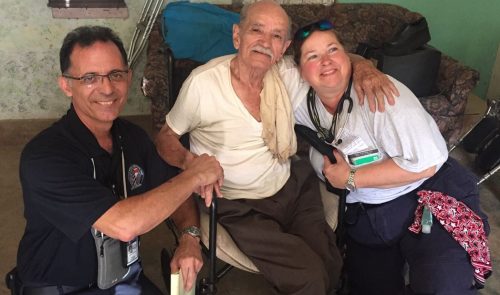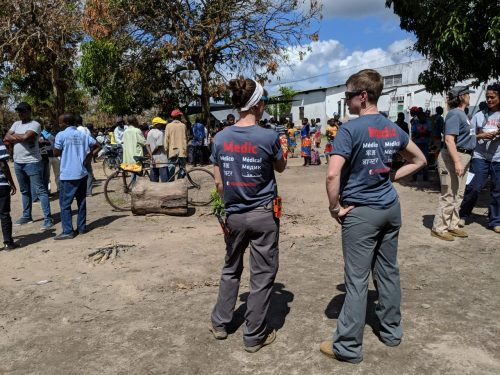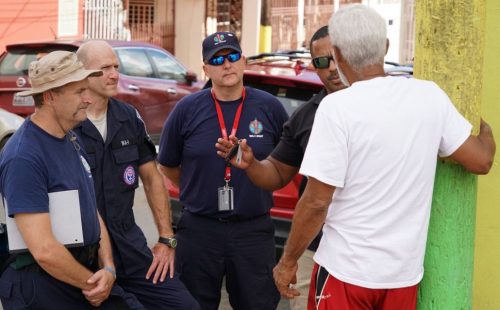How PAs Can Use Their Skills in Disaster Medicine
Four PAs offer their best advice for getting involved
September 17, 2022
By Jennifer Walker

In the decades that he’s been involved with emergency response, Frank Caruso, DMSc, PA-C, EMT-P, has often seen people going out of their way to help each other after a disaster. Caruso, who is deputy commander of a Disaster Medical Assistance Team (DMAT) in North Carolina, remembers one time in particular in the parking lot of a Louisiana Walmart after Hurricane Katrina. His team had just set up their equipment when a man riding a bicycle stopped to talk to them. The man had recently opened his tire shop across the street, which was somewhat functioning despite being hit by the hurricane, and offered to work on any of the team’s vehicles for free. Caruso was in tears. “You’ve lost your entire business and your house, and you’re reaching out to us to help us,” he says. “It was such a touching thing. That’s what makes it worth everything.”
Stories like this, along with a desire to help others when they need it the most, may be why PAs are moved to use their skills in disaster medicine. There are many ways they can get involved, from signing up with a nonprofit that focuses on emergency assistance to joining a team, such as a DMAT, a State Medical Assistance Team (SMAT), or a Community Emergency Response Team (CERT).
But, regardless of the avenue PAs choose to get involved, there is one thing that is constant: Healthcare following a disaster is different. AAPA talked to four PAs who have been involved with disaster medicine about how to be prepared for treating patients, how to handle the unpredictable nature of this work, and how to make the biggest impact on communities in need.
Participate in training. A lot of it.
Before signing up for an emergency response team, PAs should be properly trained, Caruso says. “Mass casualty triage and disaster medicine are significantly different than anything you’ve learned in PA school,” says Caruso, who works in orthopaedic surgery and co-directs the PA fellowship program at Wake Forest University Baptist Medical Center in Winston Salem, North Carolina. “We’re taught to provide the most service to every single patient. But in an austere environment, that’s not the rule anymore. You’ve got to provide the most service to the most number of patients based on the limited resources you have.”
Caruso recommends that PAs be CPR-certified and have training in Advanced Disaster Medical Response, Advanced Disaster Life Support, and International Trauma Life Support. The federal government offers many courses that medical personnel can take for free to learn about response. There’s also the ANCC National Healthcare Disaster Professional board certification examination, the only exam in the country for disaster medicine, as well as an extensive list of resources on the CDC website. PAs who decide to join a DMAT can also participate in regular training opportunities that are offered throughout the country.
“One of the things I lose team members about is that they join and they want to go tomorrow [to do] something exciting,” says Caruso, who also leads the Disaster Medicine Association of PAs, an AAPA special interest group, which he uses as an informational clearinghouse. “They don’t understand the amount of training and the constant practice drills [they need to go through]. Then when they get deployed, they can do what they need to do in a safe and efficient manner.”
Become familiar with Crisis Standards of Care.
The limited resources available to medical personnel in disaster situations changes the level of care they are able to offer to patients. “You’re running out of supplies, providers, space,” says John Donohue, DHSc, PA-C, DFAAPA, an emergency management specialist with the CDC who previously spent 32 years in the military with the Army Medical Department. “You’re trying to give the best care you can, but some of the people require too much. You’re going to have to decide what you can and can’t do. It’s a tough thing.”
Donohue, whose work involves reviewing and commenting on response plans for various disasters and hazards, recommends seeking out volunteer opportunities at a local emergency management agency. Then PAs can begin to get a feel for what it might be like to be a medical provider after a disaster. “There is always going to be a disaster somewhere and there is always going to be a need [for people to help],” Donohue says. “The more you can get involved [ahead of time], the more you know how the system works.”

Minimize harm by joining an organization with guidelines.
For PAs who want to get involved with disaster medicine through a nonprofit, First Lieutenant Jennifer Dengler, PA-C, a member of the U.S. Army Reserves, recommends finding an organization that follows guidelines to minimize harm to local communities, particularly in international locations. “Many people are not aware of the austere environments they will face and that it can be a challenge to meet the needs of the team while treating the locals,” says Dengler, who works in urgent care with Asante in Ashland, Oregon. “Providers have to be prepared to work in high-stress, limited-resource settings without the luxuries of running water and shelter.”
Some organizations may also self-deploy, which makes it hard to keep accurate records about the treatment patients receive. “It really starts to snowball into this continuum of care and whether patients are being treated appropriately because you have no idea what they have received already from another organization,” Dengler says.
Dengler decided to join Team Rubicon because it follows World Health Organization guidelines during international deployments. When Team Rubicon went to Mozambique after Cyclone Idai earlier this year, the first team flew into the country, waited to speak to the Ministry of Health to get cleared to help, then moved on to their assignment. In this way, “you’re very much under a big umbrella to make sure the patient care is appropriate,” she says.
Dengler’s team arrived in Mozambique in April 2019, a few weeks after the cyclone hit. (Her first deployment was to Houston after Hurricane Harvey in 2016, where she worked on removing material and dry wall from homes that were flooded.) There, her team was sent by larger NGOs into various villages to do WASH (water, sanitation, hygiene) assessments and medical assessments to determine if larger organizations should come in to address pressing health issues. She was deployed for two weeks.
For PAs interested in signing up with a nonprofit, Dengler recommends researching organizations to find the best fit. “Try to find something that fits your style [and] that gives you the ability to make an impact,” she says.

Be patient and persistent.
Dave Sander, PA-C, MPAS, has had to be patient throughout his long involvement with disaster medicine. He has been on three DMATs in three different states, including his current team in Seattle. The teams are on call three months every year, and each member has to pick at least one month to take the call. Sander’s teams have responded to disasters in Louisiana, Haiti, Japan, and New Jersey, among other places, but he wasn’t on call during any of those deployments. “I was on teams for probably 10 years before I went on an actual assignment,” says Sander, who works in orthopaedics at Virginia Mason Hospital in Seattle.
But Sander’s patience was worth it after he was deployed to Puerto Rico after Hurricane Maria. In the beginning, his team sat around often, which was frustrating, but eventually they found their own mission.
Once they started treating patients, Sander saw how people can go out of their way to help others. In the beginning of their deployment, for example, Sander’s team only had enough medicine to last a day, maybe less. They were driving around the Comerío area when they hit a traffic jam. Up ahead, they could see people having a party, playing music and handing out plates of food to the community. As they got closer, Sander’s team learned one of the men handing out food was also a pharmacist and he had a huge shipment of donated medicine that he was not legally allowed to dispense. Sander’s team was able to take the medicine, which they used to treat patients throughout their deployment.
Despite being devastated by a hurricane, the people in Puerto Rico were also very welcoming to Sander and his team. “People had very little, but still tried to bring us food and things,” says Sander, adding that they turned down the food so people could keep it for themselves. “They came together as a community to help themselves as much as possible, but treated us like their own. The people of Puerto Rico were pretty incredible, and it was definitely a worthwhile experience.”
This is why Sander urges PAs who are interested in emergency response to be patient and persistent. “There’s certainly something, at least in my mind, to be said for trying to help people who are at their lowest point,” he says. “[So] if you’re really and truly interested in disaster medicine and responding to these things, don’t give up.”
Editor’s note: This article originally appeared in August 2019.
More Resources
The Physician Assistant in Disaster Response: Core Guidelines
Emergency Preparedness and Response Training Resources
After Disasters, PAs Step In to Provide Critical Medical Care
Jennifer Walker is a freelance writer in Baltimore, MD. Contact Jennifer at [email protected].
Thank you for reading AAPA’s News Central
You have 2 articles left this month. Create a free account to read more stories, or become a member for more access to exclusive benefits! Already have an account? Log in.



